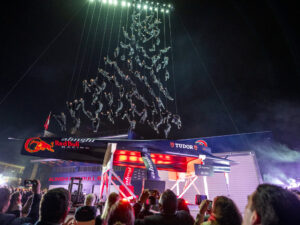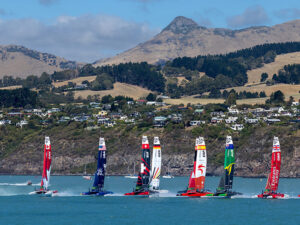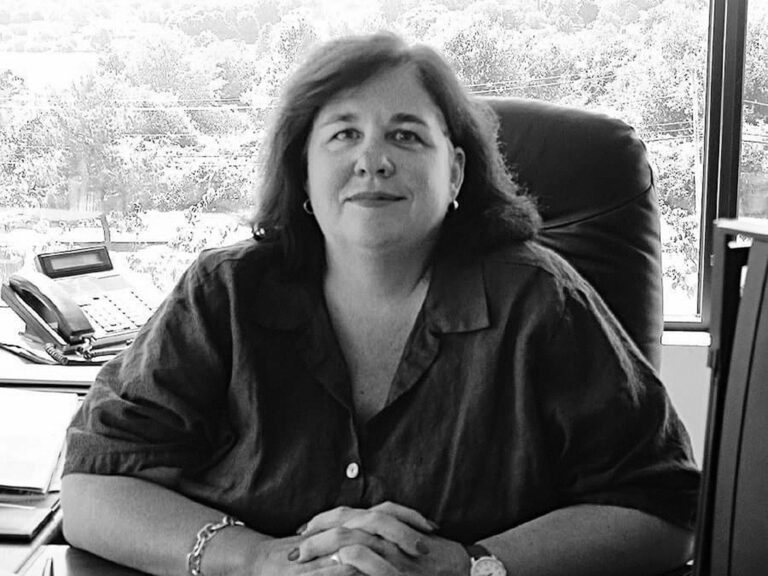These days, you don’t even need lemons to make lemonade. Well at least not directly. Some Countrytime and some water, and you’re good to go. Millions of kids do it each summer. Trying to put a positive spin on the disastrous pitchpole of Oracle Team USA’s AC72 in mid-October was much harder. While the other three syndicates surge forward with their AC72 testing program—Emirates Team New Zealand and Luna Rossa did some mock racing yesterday on the Hauraki Gulf, Artemis is working its boat up on San Francisco Bay—the defender is forced to sit, watch, and wait while the build team finishes the team’s second wing and repairs the catamaran platform.
And the physical repairs may be the easy part. The capsize had the potential to be a devastating blow to the team’s collective psyche. And without a boat there was no real way to “get back on the horse,” as they say. Mastman grinder Shannon Falcone had an idea, however. The 31-year-old Cup veteran thought they could use the parts of the broken wing sail to create an entry for the San Francisco Red Bull Flugtag event—a promotional circus where regular people “launch” homemade craft off an elevated platform into the ocean—which took place on Nov. 10. The management said, “Yes,” so Falcone started, from scratch and with only a rough idea of what he wanted to create, building in earnest.
The Oracle Team USA Spirit of 17 didn’t fly very far. But unlike in the America’s Cup, no one really wins the Flugtag. Or perhaps its better to say no one really loses. For the moment, that flavor of risk-free distraction may have been just what this team needed.
**
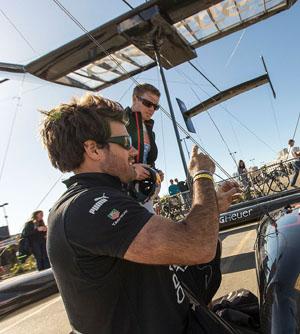
Sailing World: Tell us a little bit about yourself.**
Shannon Falcone: My parents lived in Italy until I was three, but my mom flew to England to give birth so that I could have a British passport. She grew up in Kenya, and back in the ’80s a British passport held a lot more sway in Africa. We stayed in Italy until I was three. My dad had a loft up in Florence, I think it was Horizon Sails. Then he sold his share of the loft and bought a 44-foot race boat, on which we did the Transat in ’84, from Casablanca to Guadeloupe. I was three at the time, the youngest competitor in the fleet. I think the only reason we ended up in Antigua was Sailing Week was the last event of the Caribbean circuit.
[All photos are courtesy Guilain Grenier/Oracle Team USA]
So that’s the long response. What’s your short version when people ask you where you’re from?
The usual response is Antigua. I went to boarding school in England, but that was later on. Antigua is home. That’s where my family still live, and that’s where I grew up.
Let’s get right to the Oracle Flugtag entry. Why was this an important project to do now? As a team, you’ve got plenty on your plate during the next 10 months.
It was a personal thing of mine. I remember when I discovered that it was going to be here in San Francisco, I had an idea to do it. But with the fact we were just going to be launching the 72, it just wasn’t a priority. Then we ended up pitch-poling the big boat, and there was a week where management was assessing what we were going to do, how we were going to spend resources, and what our program was going to look like from now on, while we were repairing the big boat. At exactly that moment, Red Bull was really starting to pump up their “Flugtag is coming to town” sort of thing.
Seeing the wing sitting on the floor, I called up Puma, who’s another sponsor with that kind of background, always up for doing crazy things, and Red Bull and they were into it, so at that point I knocked on the door and spoke to Grant [Simmer] and Jimmy [Spithill] and said, “Hey do you think you guys could free me up so I could build a little project for Flugtag, to give San Francisco a replay of what happened on the Bay, but also put a little different light on what could become a really big set back for the team, but for us is something that we can brush aside. Put it in a different light.”
The team was in a pretty dark place after the pitch pole, even the team’s press releases alluded to the downcast mood. Did the Flugtag project help lift the team’s collective spirit?
Grant came back with a funny reply as soon as I pitched the idea. When OneAustralia snapped in ’95, the next day the sailing team all went out wearing their life jackets, playing a joke on what had happened the day before. A lot of times in these situations, that’s what you’ve got to do. You have to manage the feedback that you sometimes get when you start something like this, about us not being serious enough. I’m not of that mindset, I disagree with that. You’re always in such a competitive environment in these campaigns that if you don’t sometimes do some special projects and things on the side you sort of lose why you’re actually doing this to start with. I got into sailing because it was fun.
What happened after you got the go-ahead?
It sort of was one minute I had the idea, the next day I was driving to L.A. to pick up the [PUMA stand-up paddleboards], and after the weekend I started building it. I really didn’t have any idea of how long it would take, and we only just got it finished the night before. I had to do a few design changes in order to get it to McCovey Cove in time. I did 10 days straight, every day and in on the weekend to finish it, and you know it’s going to get destroyed. I connected with the shore team, when they put the thousands of hours into platform one, and a week later we bring it back in pieces. Then we actually ended up jumping, and we didn’t destroy it and there was no damage after the jump. We’ve got it sitting here in the base right now, and we’re deciding what to do with it.
**
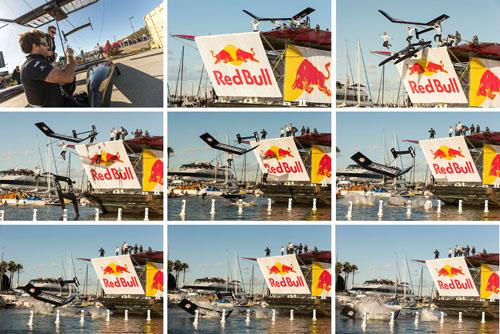
Tell us about the craft. You had a catamaran made out of paddleboards and then a glider mounted on top? **
[Originally] it was going to a one-fifth-scale model of the 72. We actually had to have the whole thing set up in the pits for the morning of [the Flugtag event]. I wanted to have it so it was a vertical wing, so people fully connected with what we’re sailing out on the Bay. Then come jump time we’d spin it 90 degrees, and it would become our flight wing. But the designers—I popped into the aero design room during the week of the build—they basically told me you need to put dihedral [upward angle of the wings] on it in order to control roll stability, so that’s why I had the 30-degree bends [on the wing tips]. And at that point I figured you wouldn’t recognize it as [a boat], so we canned the whole vertical option. For me the story line was that I used recovered frames from the wing and cut them down and built this spar just like we would build a 72 or 45 spar, with the frames and Clysar. It’s a solid spar. It didn’t fly very far. Originally we were going to fly it without any pilot because we didn’t want to risk injury. So we set up the [center of gravity] without a pilot, and we had 15 pounds of lead weight at the front. At the last minute we heard Jimmy during the announcements saying that the teams that didn’t have the crews going in the water were getting really low scores, so we just said we’ve all got to jump with. So we added [surfer Ian Walsh] as a pilot, but we didn’t get rid of the [weight]. Ian Walsh said as soon as he went over he felt the thing had lift, but then it just went into a dive. It’s got potential. I reckon it will fly.
You’re a front-of-the-boat guy, mastman, grinder, always at the whim of the program manager or skipper. For this project, however, you were in charge. Did you enjoy having the power to choose your crew?
The funny thing was—and I was really surprised—I had to twist a few arms to get a full crew. I’m not sure if: A) It was a weekend so people want to relax or head out of town; or B) If it was the fact we’re jumping off a 30-foot platform. That’s sort of how I was presenting it to them; you’ve got to get back into this, just practice another jump. You can see the Team New Zealand guys jumping off the 10-meter diving board. I said this is way more realistic because the water’s cold, and we’re going to have debris coming down with us. That didn’t get them either. Jimmy was the only one who jumped in on the idea, he usually does. The other guys, I roped in some of the young guys, told them it was a must-do. The Red Bull guys, they were easy. We ended up filling half our team with other athletes. We had Chase Kosterlitz who’s a pro paddler and Walshy and another Red Bull guy. In the end we swelled it up. We had seven on the team, plus Jimmy and [musician] Sheila E [both of whom were helping judge the event].
Sounds like it was a successful diversion for the team. Now it’s back to reality, so to speak. What’s on the agenda right now for Oracle Team USA. There isn’t traditionally a lot of wind this time of year in San Francisco. How are you keeping your days full?
At the moment, sailing team-wise, not all the sailors are here. Some are getting a break. The guys who did Olympic campaigns, like Tom [Slingsby] and Ben [Ainslie], they came in straight after [the Olympics] for the World Series, they need to disconnect for a little bit after having pushed something so big for so long. Some guys are in NZ keeping an eye on what’s going on down there. The rest of us are basically here. We’re sailing 45s, testing out a few things when there’s enough breeze: foils and things like that, which we can upscale to the 72.
This week, a lot of the younger guys are involved in the Red Bull Youth America’s Cup selection process. We’ve had young groms between 18 and 24 coming through the base.
In the gym, they have a fitness test in the morning, and you see them kind of broken [afterwards]. I don’t know any of them personally—just from their stature it looks like a lot of them are coming from Olympic-class background, and you can see a big difference. You see them coming in, and it’s like, “Whooah, these guys are small, we need to bulk them up.” The sailing skill sets could be there, totally. From what they’re coming from, I think this program’s a very different environment.
But it’s good because we’ve got a lot of young guys on the team now. We’re actively pushing to get younger guys on board. People like Rome [Kirby] who’s come in off the Volvo campaign and has a lot of big boat experience, but is the same age as those guys, could be a good role model for those guys to look up to.
Rome was a dinghy sailor in his youth, but he put on a tremendous amount of muscle leading into that Volvo campaign
When I was 19, I was 90 kilos [198 pounds], and I put 15 [33 pounds] on during my first campaign. I was 105 [231 pounds] at the end of Mascalzone [during the 2003 America’s Cup], and at Luna Rossa I put on another 20 [44 pounds]. I got up to 125 [275 pounds], so that’s 35 kilos [77 pounds] in a three-year period.
What do you see your weight for this boat?
I’ve dropped it now. Since we knew we were going multihull, I was in at about 118 [260 pounds] and I’ve dropped basically 15. I’m coming in generally at about 103, 104 [227 pounds]. And I think for race trim, I’ll be down to between 100 and 102 [222 pounds].
**
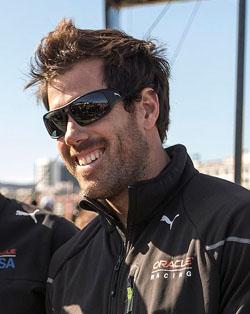
People have predicted that the grinding on an AC72 will be more constant than it was on the old ACC boats, where it came in quick bursts. Is this true?**
It’s definitely a different style of grinding. We see that reflected in our physical training. Before we did a lot of weights, explosive stuff, and that’s why we were all so big. Now our training has turned more to high-intensity interval training like Crossfit-style stuff where we do a lot of finishes which are maybe 20 or 30 minutes long. So we have our heart rates at 80, 90 percent the whole time, and we’re doing things to get that heart rate up, either grinding or doing shuttle runs, and in the middle of that we throw in physical, explosive stuff.
On the old AC boats, even if you had a tacking duel, and you were grinding non-stop, that was it, you were on the handles and [didn’t have to move]. Here you totally mix it up because you’re grinding, you’re maxed out, then you have to sprint across the platform, while you’re doing 30 knots and trying not to get knocked off your feet. The whole running aspect between the grinding definitely changes the physical demands on the body. Just staying on your feet when you’ve done 20 minutes at 80 or 90 percent, your stability starts to waver.
We’ve heard a lot from the back of the boat on what it’s like to sail these AC72s. What’s it like up forward? How much do the front line sailors enjoy sailing the AC72?
It’s basically totally wrecked any other sailing that I do. When the Cup campaign finishes, it will be difficult to get back to other boats.
The difference with these boats, what we feel forward, is something you always talk about, and now that we’ve done it, now that we’ve pitch poled, it’s sort of…it’s always on your mind. When the conditions start to get tough, it’s something that you’re always sort of discussing between maneuvers. Not in a playful way, but the fact that you’re actually addressing it means it’s a thought that’s always in the back of your mind: where are you going to go, what are you going to hold on to. It’s always something that’s there, and that risk is something that has entered the game that was never there before.
Before, on a Cup boat, when I was mastman, the only time I ever thought of risk was when we were coming into a luffing scenario going downwind and I was around the mast area and I would just shuffle behind the jockey pole because the risk for me was that the jockey pole could snap and take me out, or a spinnaker pole could break.
Here you have it in the sense that when things go bad, they go really bad, and we saw that on October 16 with the 72. It’s something that hadn’t happened, it’s totally changed our program, but I don’t think it’s something that will stop our defense of the Cup.
After the capsize, it seems that all the teams have taken the opportunity to review their capsize safety and recovery protocols. And everyone’s taking it a lot more seriously. Emirates Team New Zealand went to an indoor diving pool to jump off the 10-meter board. How much has your protocol evolved?
It definitely was a big wakeup call. Not so much the pitchpole, because that’s something we had talked about. For example, when I was out there, because I was involved in the rescue, I just wished I had my Volvo grab bag. I think anytime we all thought of it happening, it was something that we—or I—thought would be local within the Bay. It was always going to be inside of the bridge.
But by coincidence or chance or fate, that one day there was a 5-knot plus ebb tide, and it was blowing 25. An hour after [the capsize], we’re outside [San Francisco Bay] in standing waves. Then darkness came so it became more of an offshore thing, you want to make sure everyone’s got strobes on, and everyone’s got an EPIRB. I would’ve felt a lot more comfortable if we had. In the end, you can’t mess around in San Francisco; it’s cold and conditions can change really quick. That’s what caught me out, “Hmm, I could’ve personally been better prepared for this by having a few Volvo gadgets on me.” But you don’t think about that when it’s 3 p.m. and you hear the boat has capsized. I jumped on the chase boat wearing shorts and T-shirt.
Our protocol has totally changed now. We still have a committee working on … I don’t want to ever say it’ll happen again, but we have totally changed how things happen when it does happen again. It’s a big rescue organization, a lot of people out on the water. I’m sure we could’ve done things differently that may have cut down the workload we find ourselves with now with regard to the repair job.
On that day there were a lot of factors that played against us and things just snowballed—tide and darkness and those kinds of things—and we found ourselves in a situation where at that point, it was just try to save the platform.
[Among the things being revisited is our tender fleet.] When we’re out there at 11 p.m. at night, and we’re trying to get the platform back to San Francisco, and we’re basically just holding station against an ebbing tide, you’re thinking, “I wish we had a more powerful chase boat.” When you start a campaign, you’re thinking, “Do you always have to prepare for the worst?” Usually you don’t [need that preparation], but there’s that moment that you may need it, and that’s when it comes good. Things like fuel, we never even thought of needing that kind of fuel capacity. We had to rotate chase boats through so they could come back to San Francisco and fuel up.
**You’re one of the few people to have sailed on the 90-foot USA-17 trimaran, on a Volvo 70 (with PUMA in 2008-’09 and one leg in 2012) and an AC72. What’s the tensest scenario: the 90-footer in 10 to 15 knots, the Volvo 70 in the Southern Ocean, or the AC72 in San Francisco Bay? **
If I had to choose one right now, it would be the 72; it’s definitely the one that keeps you on your toes the most. It could be simply a comfort thing in having not sailed that boat enough, so we’re not up to speed. Definitely a 25-knot day in San Francisco, with chop, the fact that the boat eats up so much distance, if something goes wrong—if you get a bad furl—you do not have runway to sort it out really. That boat is definitely pushing the limit with design and the way we’re sailing it. The Volvo 70, Southern Ocean, even in 35 knots, there’s a risk, but the risk there is different, it’s losing someone overboard and not finding them and being far from help. [On the Volvo 70] you broach, you wipeout, you stuff it down into a wave…I remember the first time that happened. It was just leaving Cape Town, like three days out, I felt so bad getting knocked off my pedestal, I thought, “I’m such a rookie.” Then I stand up, and I’m the first one on my feet. The guys who had done four ’round the worlds were already laughing it off. There’s still a bit of a buffer. Things don’t break. You can enjoy it, you can push, you can broach and come back and keep going. Here there’s no keep going; if you go over the edge, it’s game over.
Check out Oracle Team USA’s video of Flugtag:
Check out more photos from the America’s Cup this month here.



